Ay Tequila!

Ay Tequila!
It’s been about a decade since I last stepped foot in the state of Jalisco and visited Tequila. I was curious to see how it matched up with my memories.
It started off well as we were greeted by a spectacular view of heavy clouds rolling over a dramatic mountain range as we crossed the border from Michoacán. So far so good. Next stop Tequila.
Tequila, designated a Pueblo Mágico in 2003, is a town famous for the production of its namesake liquor. Most visitors come from Guadalajara. The drive to Tequila from Guadalajara is roughly an hour and a half by car. It makes a good choice for a day trip or overnight stay.
We did a stopover in Tequila in Jalisco when we drove from Merida, Yucatan to Puerto Vallarta, Jalisco (a 5,000km round trip but that’s another blog).
The distance from Puerto Vallarta to Tequila is about 170 miles (270km) and took us a little over four hours. That’s a bit more than a day trip!
Must-dos in Tequila
1. Visit the Agave fields
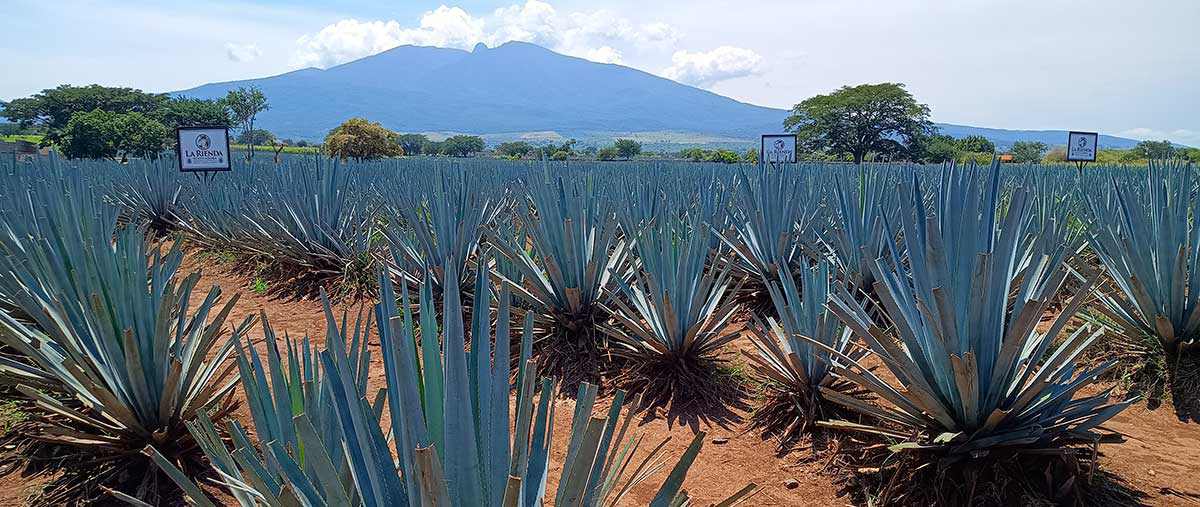
Rolling fields of blue agave plants are a quintessential sight around Tequila and, one could argue, a must-have photo. There are a few designated miradors (lookouts) along the highway designed for cars to pull over and appreciate the view.
You could also opt to visit Agave plantations or places such as Paraiso Azul, an ecotourism complex only 15 minutes from downtown Tequila. There you’ll find good views, photo opportunities, an infinity swing and some zip lines.
By the railroad tracks between Tequila and Amatitán on the way to Cantaritos El Guero, there’s a little area where you can pull over. It’s a great spot to take pictures of the railroad, surrounded by agave plantations, the Tequila Volcano, a swing and a heart.
Tip: If you decide to pull over near the railroad, take your pictures with the swing and heart quickly. Someone from the nearby drink stalls may come over to offer to take pictures. If you decline, they will obstruct your views.
Tip: If you’re not an avid Instagrammer, you may want to skip Paraiso Azul.
In 2006, UNESCO declared Tequila and the surrounding area the ‘Agave Landscape and Old Industrial Facility of Tequila’ a World Heritage Site. Locally, it’s more commonly known as ‘Paisaje Agavero’.
2. Take a distillery tour

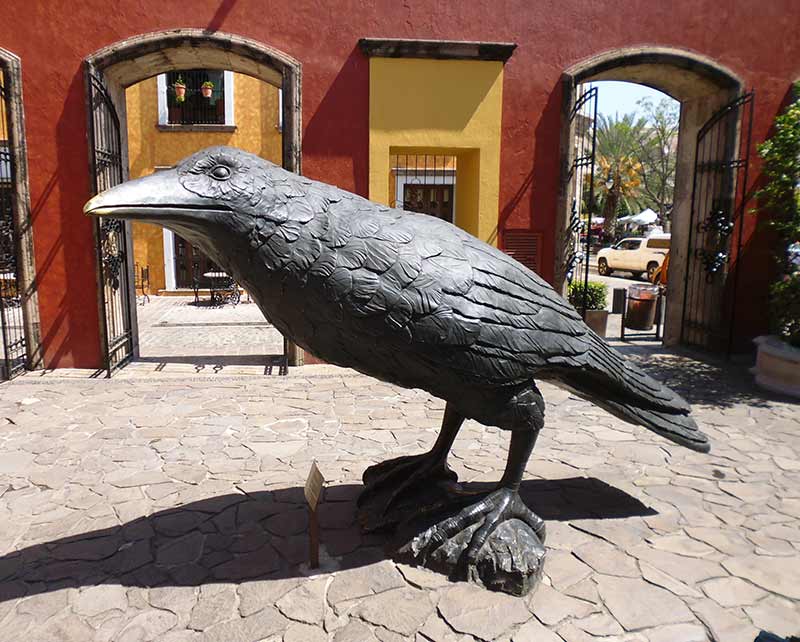
Learn how this iconic drink is made by taking a tour of one of the many distilleries such as the famous José Cuervo or Casa Sauza. You’ll gain insight into the history and making process of the alcohol, the work of the jimadors. And, of course, get the opportunity to do some tasting and drink tequila! So, if you’ve ever asked ‘What does tequila taste like?’ – a Jose Cuervo Tequila Tour will answer all your questions!
Jose Cuervo Distillery is the easiest to find in Tequila as Casa Cuervo is just across from the main plaza. It is also immediately recognizable by the large crow statue! If you walk down the side road, you’ll come across the main distillery.
Jose Cuervo is also the best selling tequila worldwide. It is responsible for a fifth of all tequila consumed!
Why so the crows? Cuervo is Spanish for crow. Jose Cuervo allegedly starting using a crow as a brand mark in 1795 to help illiterate and non-Spanish speakers recognise his casks.
You can even sign up for more elaborate tours. Some tours include horse rides through the Agave fields and making your own cantaritos, another drink famous in the region.
3. Tour around town in a Tequila Barrel (you know you want to)
For some tacky tourist fun, you could take one of the many Tequila tour barrel buses. Busses seem to gather at the side of the square opposite the church.
Double-check with the touts what’s included in the Tequila tour and where it goes. Most of these tours offer free tequila drinks as well. Other bus shapes to choose from include chilli peppers and tequila bottles.
4. Try the Cantaritos
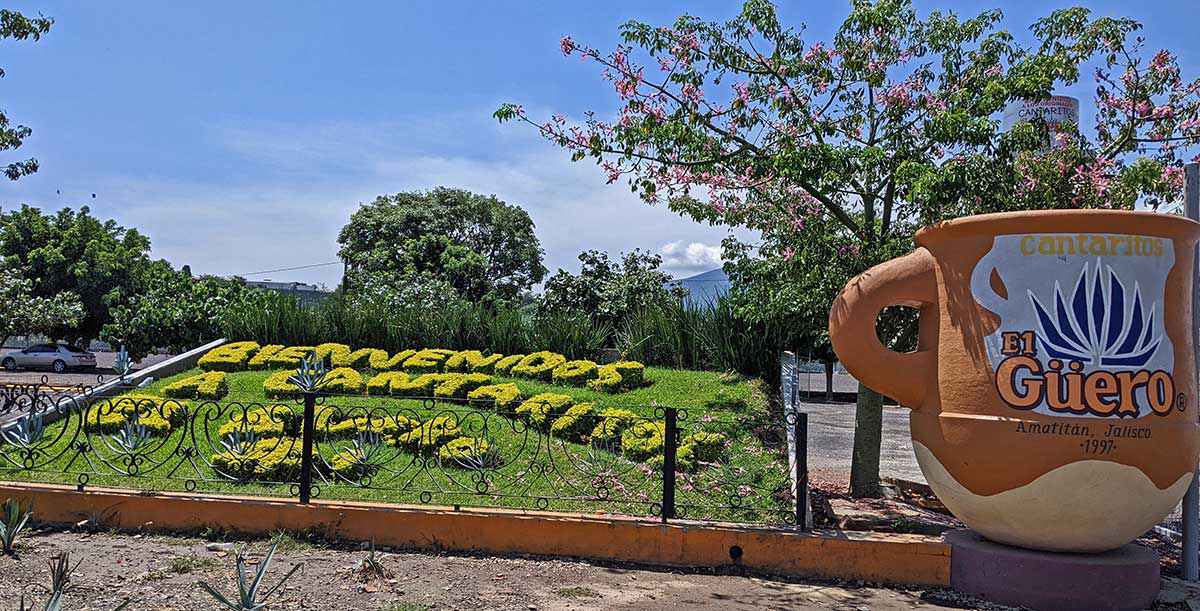
Another drink local to the region is the cantarito. This is a mixture of tequila, Squirt (similar to Sprite), a mixture of orange and grapefruit juice and a dash of salt and lime. The drink is served in clay jugs or cups which you typically get to keep. This stems from their history as a takeaway drink and the clay vessels served as a convenient to-go cup.
Supposedly, the original and best place to try them is Cantaritos El Guero, Tequila. You’ll find this place on the road to Amatitán, unmissable and advertised by a giant cantarito cup. It was pretty quiet when we arrived and we weren’t quite sure how it all worked.
What you need to do first is choose your drink from the menu, then go around the corner and pay for your drink at the cashier. Only then should you go back to the bar. Tell them your order, watch your drinks being theatrically made and enjoy.
Tip: We’ve read that the cantaritos sold in the Tequila Plaza aren’t very good quality. However, we didn’t try them so we can’t verify that claim.
5. See the Tequila Plaza and the Historic Centre
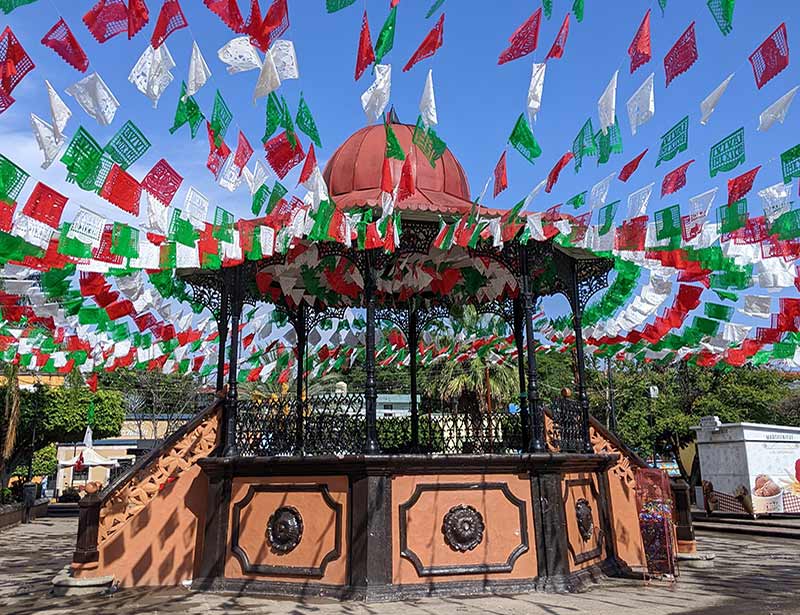
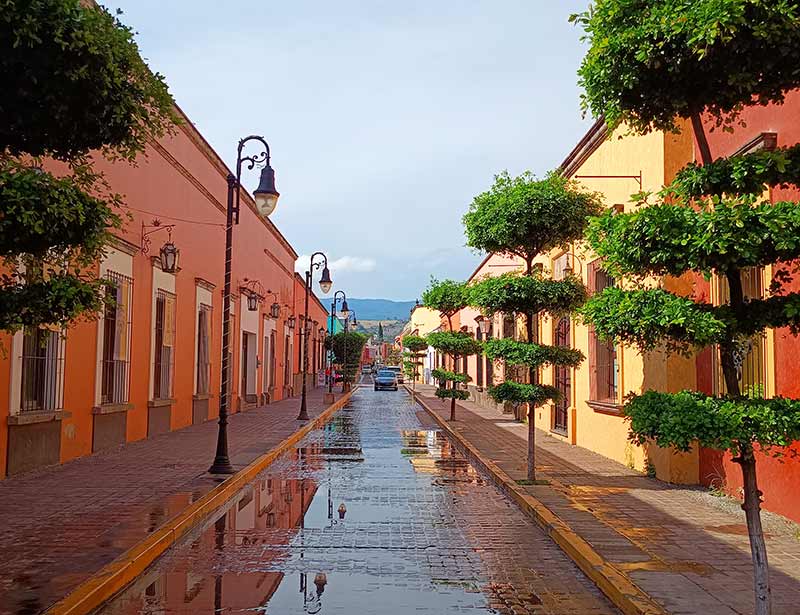
The plaza boasts the ubiquitous town letters along with a church and pretty kiosk. There’s a pathway that runs between the José Cuervo distillery and the Fonda Cholula restaurant that is very pretty and lined with topiary trees and papel picado (bunting).
Unfortunately, our visit coincided with one of the many fiestas taking place in the area. The charm of the plaza and church was a bit lost as the plaza was packed with assorted fiesta paraphernalia and boisterous crowds. Drink and food stalls vied with the sort of kiddies rides you see in fun fairs. It seemed that every space had some form of entertainment for the youngsters. People of all ages were having enormous fun!
6. Enjoy Personally vetted food and drinks in Tequila
Cantaritos El Güero #1
The best place to try the original cantarito. Prices start at MXN$135 with tequila and MXN$80 for alcohol free. The drinks were pleasant enough but the theatrics involved in making the drink made it a worthwhile trip.
Address: Carretera Internacional Libre Guadalajara – Tepic km 49 #4970, La Meza, 45380 Amatitán, Jal., Mexico
Pizzería El Tejaban
Eat handmade, wood-fired pizza in a small courtyard setting. We enjoyed the quiet setting, markedly in contrast the loud noises from the plaza and the boisterous car drivers, all of whom were heavily into the fiesta spirit!
Address: Jesús Rodríguez de Hijar 25, El Rastro, 46400 Tequila, Jal., Mexico
Tip: Opens at 2 pm. Closed Tuesdays
El Palomar
Popular café-style restaurant. A menu with lots of options and a view upstairs of the church and plaza. El Palomar is a nice café with a decent menu and reasonable prices.
Address: Vallarta 2, El Rastro, 46400 Tequila, Jal., Mexico
Tip: It’s quite popular and gets very crowded, so pick your times to go.
7. Travel further afield
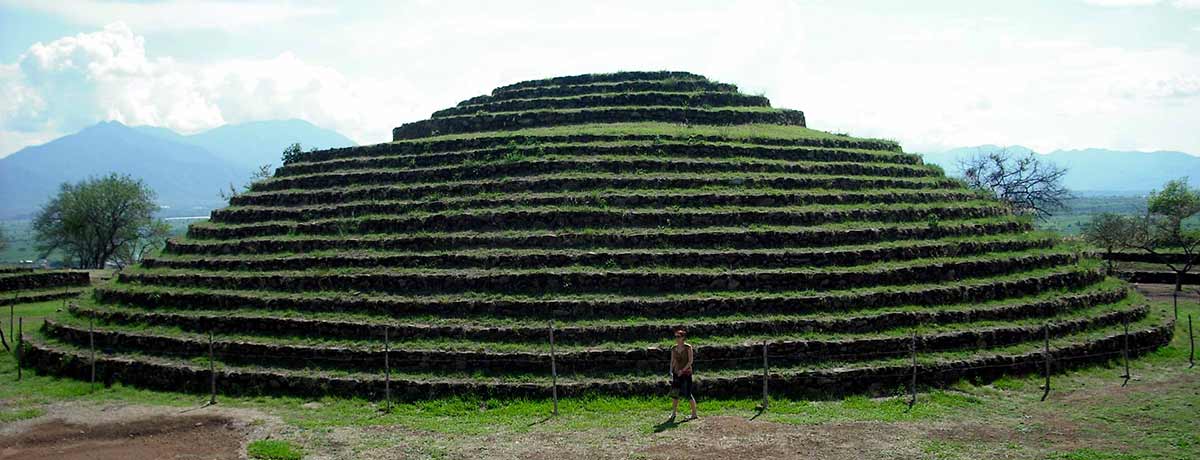
If you’re feeling a little more adventurous, you could take a trip to the Guachimontones Pyramids. Located an hour away from Tequila, this archaeological site features grass-covered stepped, round pyramids built by the Teuchitlán culture. We found it very interesting.
You can also check out some of the surrounding towns like Amatitán, Magdalena, El Arenal and Etzatlán.
Tip: The entrance fee to the Guachimontones is MXN$30. Bring sunscreen and hats as there is little shade. Closed Mondays.
Magdalena – famed for its opals!
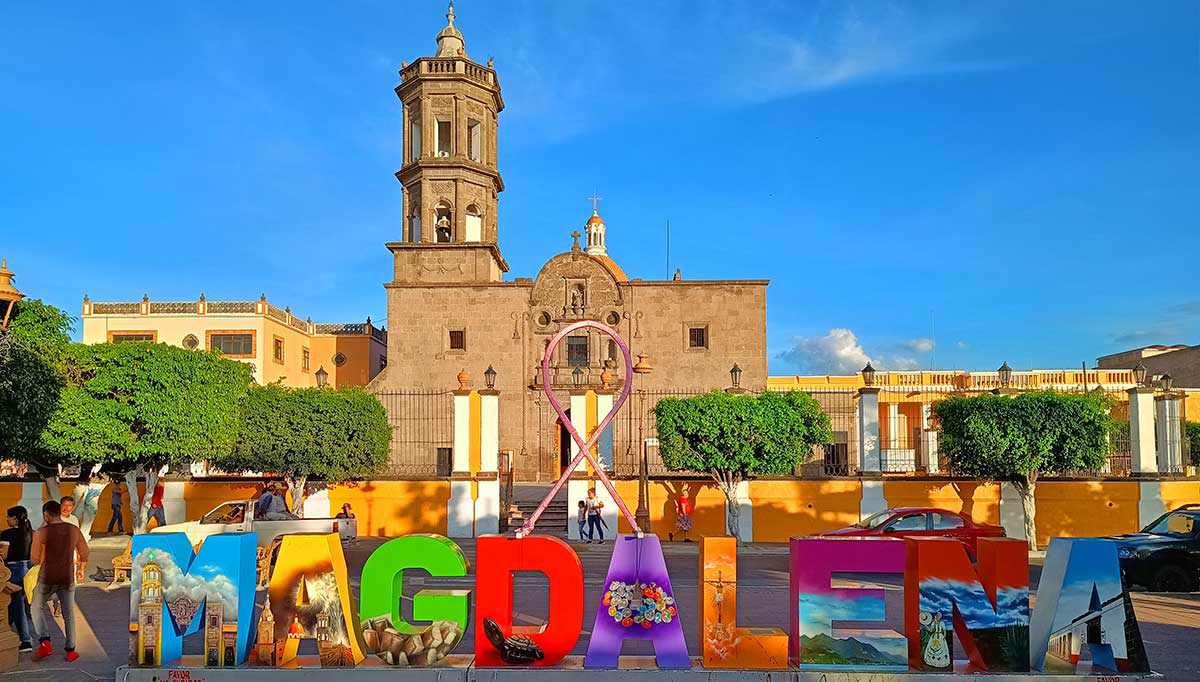
Magdalena is a small town not far from Tequila, which is a part of the ‘Paisaje Agavero’.
From Tequila to Magdalena takes less than 20 minutes by car. It can be an afternoon trip or easily explored as part of a day trip to other towns.
This town is famous for its fire opals. As you drive through, you’ll see several shops and jewellers advertising the sale of opals. The signs are in languages as diverse as Russian and Japanese. Unfortunately, we didn’t have time to stop on our trip, but I would have loved to poke around some of these shops.
Besides the opal stores, you can see examples of Baroque architecture in some of the state houses and look around the various churches and chapels. To learn more about the town and its history, visit the Interpretive Museum of Agave Landscape and Mining. In the courtyard, you’ll find a mural that illustrates the famous legend of Magdalena.
And, of course, no trip to a pueblo would be complete without wandering around the main plaza and taking a photo in front of the letters.
If you fancy a drink or decide to stay overnight, the Hotel Real Quinta Minas offers a simple, rustic and affordable hotel and bar/restaurant with tables and chairs outside on a little pedestrian street.
September is a good time for festivals in Magdalena
In the month of September, you can also witness the ‘fiestas patrias’ going through town which celebrate the regional cowboy culture. You’ll see men, women and children dressed up in their finest regional outfits riding through town on horses as part of the procession.
On top of this, there’s also the Festival of Opals (Fería de los Ópalos) held in September too. Although this seems to be more of a music festival, it also features processions through town. If you’re feeling even more adventurous, you can take a tour of the Magdalena opal mines and even search for your own opal!
Tip: There’s a map of the main attractions of Magdalena located in the main plaza.
Finding the Magic in Etzatlán
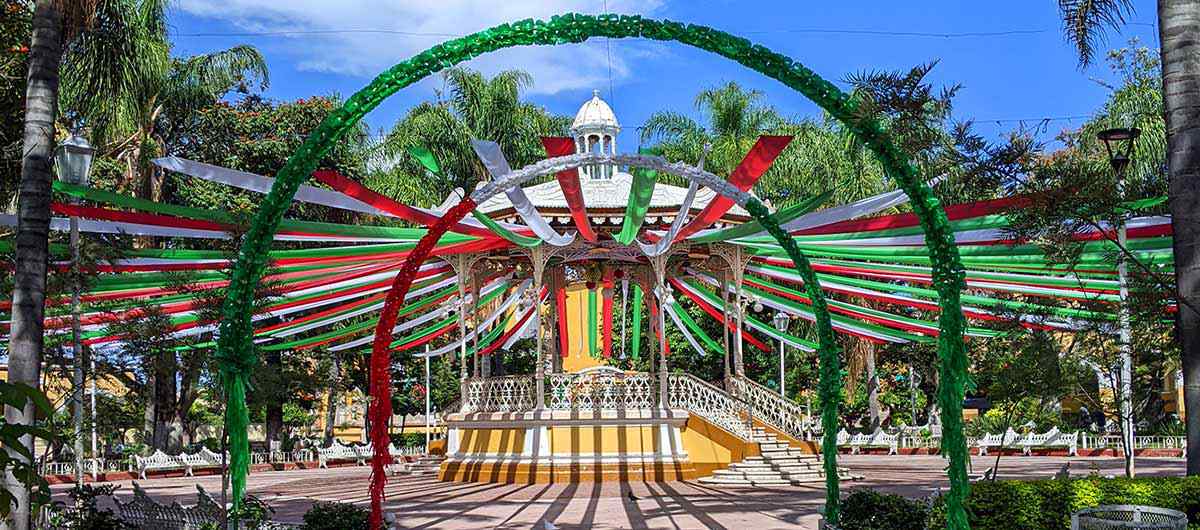
Outside Tequila lies the pretty town of Etzatlán. It is only 50 minutes from Tequila to Etzatlan, so it’s a great day trip from Tequila.
Colourful letters off the main highway announce the entrance to this town. Turn off the highway, carry on a little and you’ll come to a roundabout decorated with metal heron sculptures.
The Hotel Canteria sits just opposite and looks like a perfectly decent place to spend the night. From there it’s a short, cobblestoned drive to the main plaza. Etzatlán’s plaza is as charming as it is typical, and at the time of our visit, practically deserted.
We visited on a Monday afternoon – not the best time to visit anywhere in Mexico as places often close on Mondays. It did, however, make for a very peaceful visit.
Shaded by large trees, the plaza is ornamented to one side by the large yellow-hued church. The plaza is bordered on the other side by the arched portals that run along next to the town hall. In the centre was an ornate wrought-iron kiosko that was still festively decorated with white, green and red ribbons from the recent Independence Day celebrations.
One of the things that was immediately apparent and that truly impressed us was how clean and well-kept the town was. It seemed like a place where the citizens genuinely cared about their town. No matter which street we turned down, they all appeared well cared for.
This was a direct contrast to Tequila, which despite being ‘pueblo mágico’ and having tourist bucks pour in, still managed to feel run down and filthy. It seemed as though all of the magic had flowed out from Tequila and down into Etzatlán.
The Town with the Woven Sky
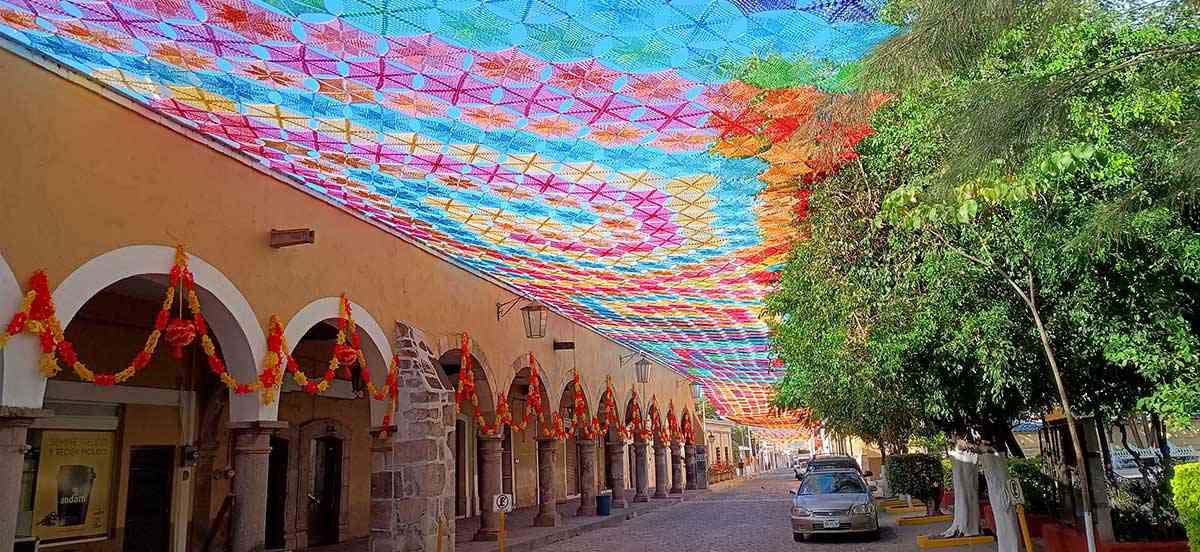
What to do in Etzatlan? A lot more than Tequila! To one side of the plaza, my eyes were drawn to a crocheted canopy covering a section of street between two blocks. Interestingly, crochet street covers are Etzatlán’s claim to fame. In fact, you’ll find this town listed in the Guinness Book of World Records for holding the record for the largest crochet canopy. It measured 2,833 metres squared!
Tip: You can find the framed Guinness World Record certificate in an office in the town hall.
As we walked along the front of the town hall we passed a little office with open doors containing two women and a pile of crochet. They were gracious enough to take the time to tell us a little bit about Etzatlán and its famous canopies.
The women showed us some of the crocheted pieces. They explained that it takes a little over 200 women to crochet the pieces necessary to make the canopies, as well as women to sew the pieces together. Each crocheted hexagon uses an entire skein of plastic raffia and takes three hours to make.
The final canopy will require roughly 24,000 pieces and cover about 11 blocks of the town! The massive canopy remains in place from October to March and then taken down when the rainy season starts. It would certainly be a beautiful sight to see, and I was sorry we came a month too early.
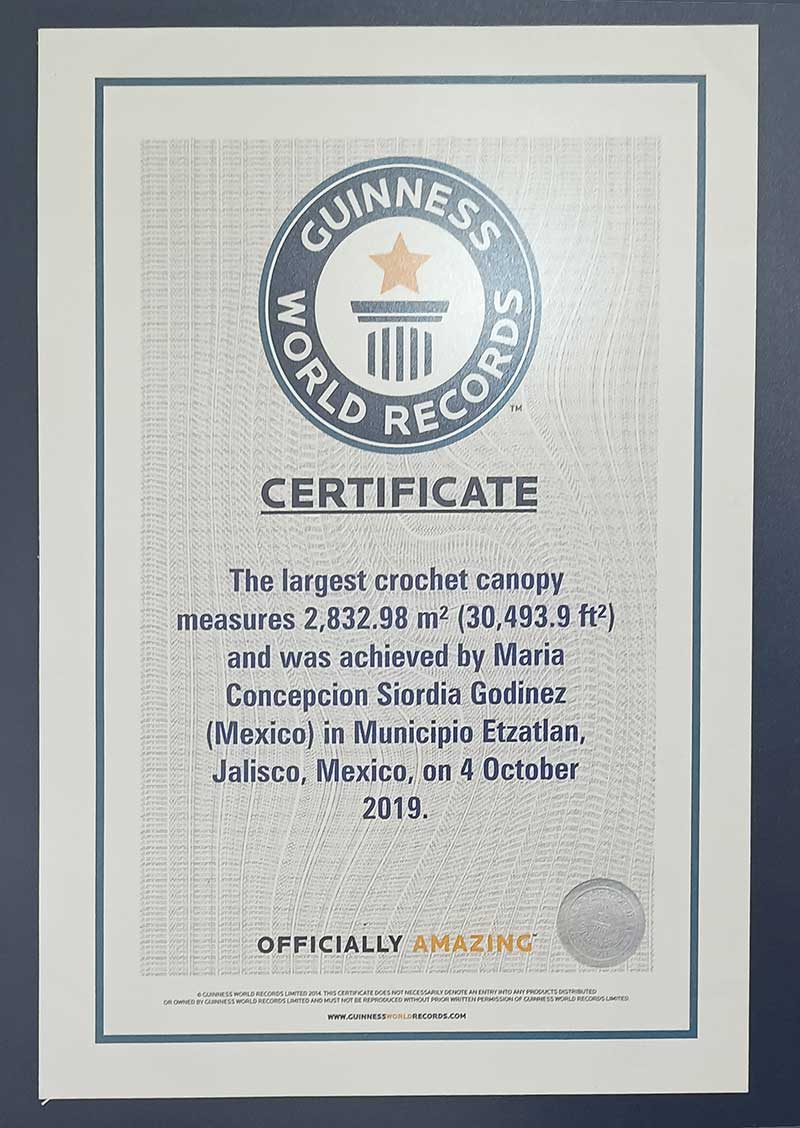
Putting on the Nosebag
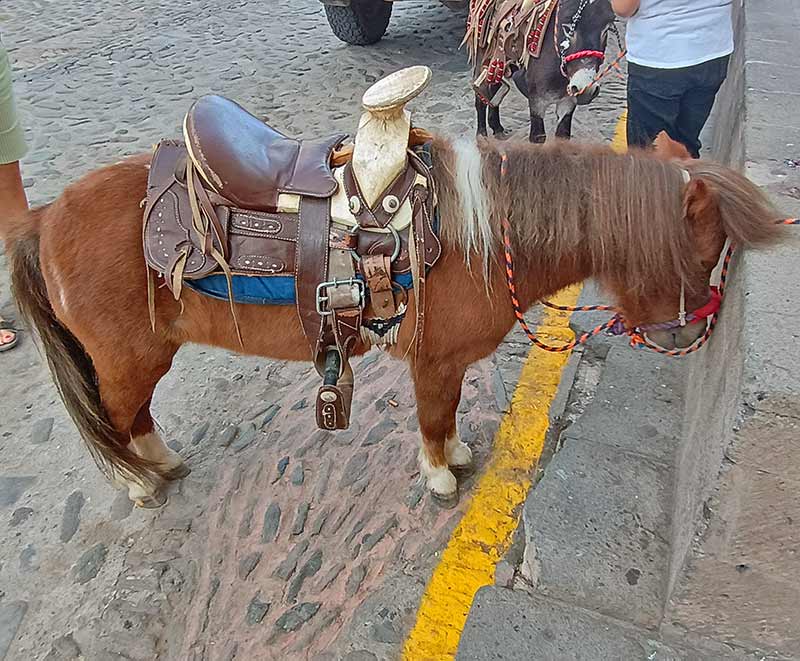
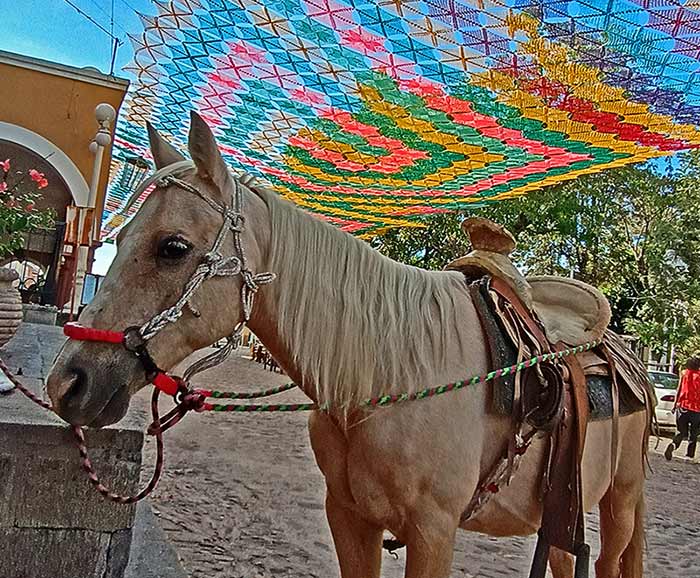
At the other end of the street, we found a nice little place to stop for a drink. El Portal is a little bar that serves alcohol and fruit juice. The inside is decorated in a charro/cowboy theme, complete with skins and skulls on the walls. The bar stalls had saddles instead of seats, making it quite a fun and pleasant place for a drink.
This seemed like a nod to the cowboy culture of the town. One of the things that brought us here was the promise of seeing men and boys riding horses through town or practising their lasso techniques in the plaza.
Alas, we never saw any of this. (However, the horse manure ground into the cobblestones testified to the fact that horses do indeed pass through town.)
Tip: The owner of El Portal is friendly and speaks English.
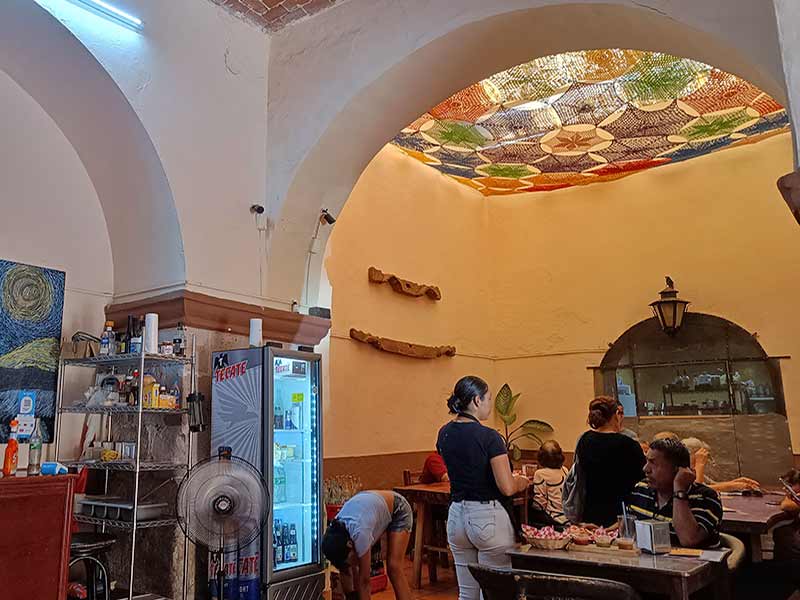
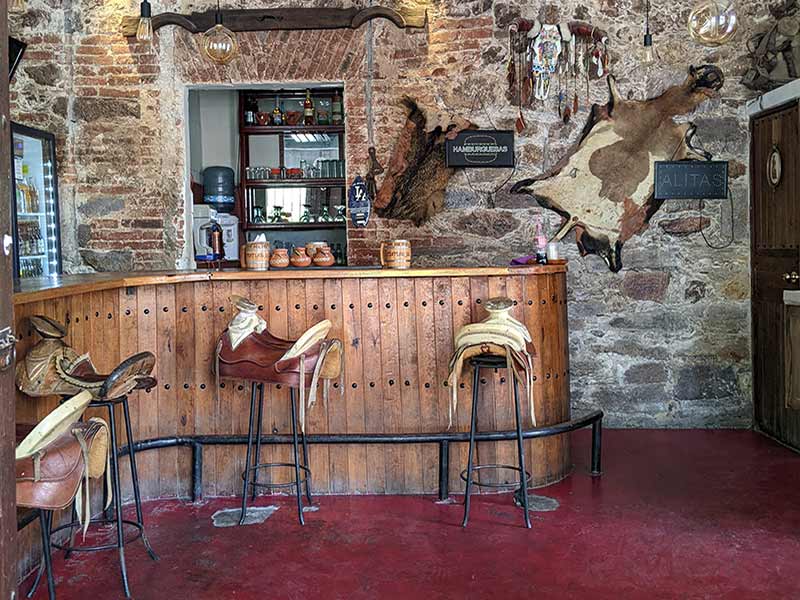
If you fancy more than a drink, El Zaguán, literally just around the corner from El Portal, is a good option with a large menu. Further outside of the plaza, Casa Don Luis serves food in a regional rustic setting nestled among the mountains and offers lovely mountain vistas from the balcony.
On the other hand, if you’re only after something to cool you down, try out Las Nieves de Garrafa, located in the plaza itself. This little retro kiosk offers different local frozen desserts such as raspadas and nieves in a variety of fruity flavours- and, of course, you’re in the prime location to enjoy the plaza.
Final Thoughts on Etzatlan
On the face of it, Etzatlán doesn’t have a huge amount to offer visitors staying for more than a brief visit, but its lack of ‘over touristification’ may actually be its saving grace. If you like charming authentic towns, pretty plazas and a slower pace of life, then this little town should be right up your cobblestone street.
This is a good option for day trips or even an overnight alternative to Tequila. Although not officially designated as one, Etzatlán certainly felt like a magical little town.
Honest Thoughts on Tequila
The following paragraphs may be controversial as I know many people visit and enjoy the town of Tequila. For me though, it was a massive let-down. I remember visiting Tequila in 2012 and finding it a small but fairly charming town with a handful of smart-looking distilleries and restaurants.
Back then, there wasn’t much in the way of souvenir shops (boy, has that changed!) and the only shopping I recall was a little indoor market off the plaza where members of the Huichol community sold their crafts. Sadly, this seems to have vanished since.
The Reality versus Memories and Online Imagery
In my mind and based on pictures and hotels I’d seen online, I imagined Tequila retaining its charm and catering to a boutique, rustic experience. I didn’t quite find this to be the case and my expectations and memories didn’t meet the modern-day reality. (Can’t always trust what you see online, right?)
It was a bit unfortunate that our arrival coincided with a fair and the main square, for the night we were there, was entirely taken up with tacky rides and filled with noise and people. Restaurants were crowded and blasting loud music. This was far from the peaceful town I had envisaged.
The road our Airbnb was located on, as well as the two-block walk from there to the plaza, did little to improve my impression of the modern Tequila. Rundown, dirty and dark are words that sprang to mind and we had to play hopscotch to avoid all the dog mess on the pavements.
Does Tequila really qualify as a Pueblo Magico?
Why isn’t the money from tourism being put back into the upkeep of the town? I expected a little more from a Pueblo Mágico. Very little effort appears to have been put into making the town attractive or even interesting. The town seems to rely entirely on it’s link to the drink that bears its name. And maybe all that’s necessary to keep tourists coming. Which is a shame.
You only have to compare Tequila, a Pueblo Magico, with Etzatlan, which is not. The difference in the cleanliness and pride in the different towns is strikingly obvious. Perhaps Etzatlan is better without the tourists?
Realistically, there are not that many things to do in Tequila, Jalisco, once you’ve walked the Historic centre road, gone to Jose Cuervo and sat in the town square.
After snapping a few pics, we came to the conclusion that we had ‘done’ Tequila and wanted to move on.
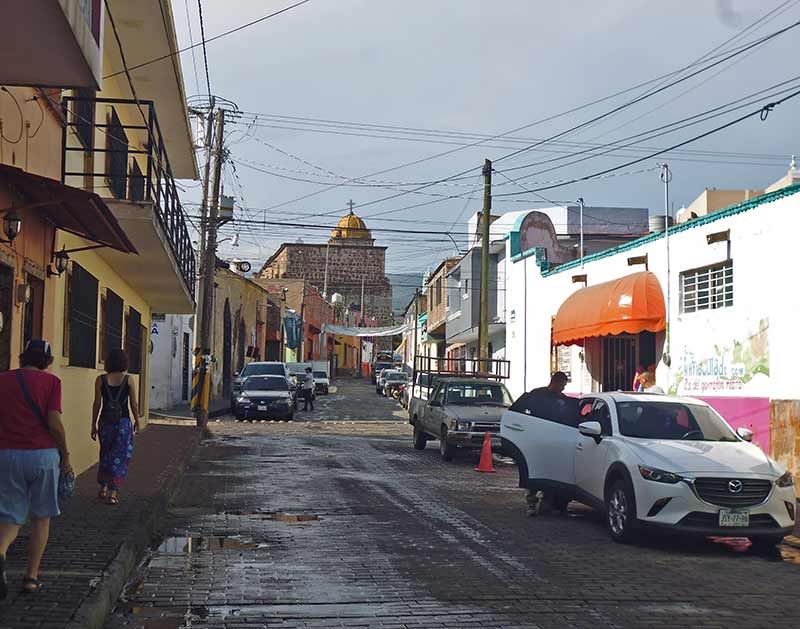
Categories:
Copyright 2024 www.wonkycompass.com